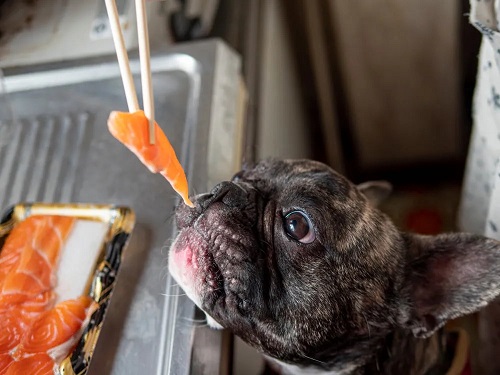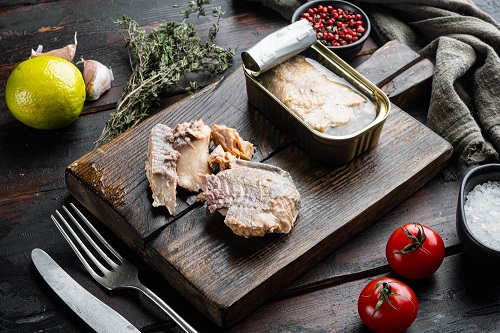Can Dogs Eat Salmon? Is it a good idea to feed fish to your dog on a regular or occasional basis? Time to find out the answers!
Can Dogs Eat Salmon? Well, thought it is a really good protein-rich option for us humans, but can we say the same for dogs? Let’s find out!
What is Salmon?

Salmon is a type of fish that belongs to the Salmonidae family. There are several species of salmon, including Atlantic salmon, Pacific salmon, and sockeye salmon, among others.
Salmon is known for its distinct pink-orange flesh and is a popular food item around the world. It can be prepared in various ways, including grilled, baked, smoked, or poached. Salmon is also commonly used in sushi and other Japanese cuisines.
Can Dogs Eat Salmon?
Yes, dogs can eat salmon, but it’s important to feed it to them in moderation and in the right way. However, feeding your dog too much salmon or serving it improperly can lead to some potential risks.
Is Salmon Safe for Dogs?
Yes, salmon can be safe and healthy for dogs to eat when fed in moderation and prepared correctly.
However, it’s important to note that not all dogs may tolerate salmon or fish well. Some dogs may have an allergy to fish, including salmon, which can cause symptoms such as itching, hives, swelling, vomiting, or diarrhea.
How Much Salmon Can Dogs Eat?

The amount of salmon that dogs can eat depends on several factors, including their size, age, activity level, and overall health. Generally, it’s best to feed salmon to dogs in moderation as part of a balanced diet.
As a rule of thumb, a healthy adult dog can eat up to 1 to 2 servings of salmon per week, with each serving being about 1 ounce per 10 pounds of body weight. For example, a 40-pound dog can safely eat up to 4 ounces of salmon per week.
Health Benefits of Salmon
Salmon is a nutrient-dense food that can provide several health benefits for dogs when fed in moderation. Some of the key health benefits of salmon for dogs include:
- Rich in Protein: Salmon is a high-quality source of protein, which is essential for building and repairing tissues, promoting healthy muscle development, and supporting a strong immune system.
- High in Omega-3 Fatty Acids: Salmon is an excellent source of omega-3 fatty acids, which have anti-inflammatory properties that can help reduce joint pain, improve skin and coat health, and support brain and eye development.
- Vitamins and Minerals: Salmon is also rich in vitamins and minerals, including vitamin B12, vitamin D, selenium, and potassium, which are important for supporting overall health and well-being.
- Supports Cardiovascular Health: Omega-3 fatty acids found in salmon can help improve blood flow and reduce inflammation, which may help lower the risk of heart disease and stroke.
- May Reduce Cancer Risk: Some studies have suggested that the omega-3 fatty acids found in salmon may help reduce the risk of certain types of cancer, such as breast, prostate, and colon cancer.
Can Dogs Eat Salmon? A Few Health Concerns
While salmon can provide several health benefits for dogs, there are some health concerns to keep in mind when feeding it to them. Some of the potential health risks of feeding salmon to dogs include:
- Bones: Salmon bones can be a choking hazard for dogs, and if ingested, they can potentially damage the digestive tract.
- Parasites and Bacteria: Raw or undercooked salmon can contain parasites or bacteria, such as salmonella or listeria, which can make dogs sick.
- Mercury and Environmental Pollutants: Salmon may contain environmental pollutants, such as mercury or polychlorinated biphenyls (PCBs), which can accumulate in the fish’s fatty tissues and potentially harm your dog’s health if consumed in large quantities.
- Allergic Reactions: Some dogs may have an allergy to fish, including salmon, which can cause symptoms such as itching, hives, swelling, vomiting, or diarrhea.
Can Dogs Eat Salmon? What Type?

When it comes to feeding salmon to dogs, it’s important to choose the right type of salmon that’s safe and healthy for them to consume. Here are some tips on choosing the best type of salmon for your dog:
- Fresh vs. Canned Salmon: Fresh salmon is a good option for dogs, as it is less processed and typically contains fewer preservatives and additives than canned salmon. However, canned salmon can also be a good option, as long as it’s packed in water and doesn’t contain any added salt, seasonings, or other ingredients that could be harmful to your dog.
- Wild vs. Farmed Salmon: Wild salmon is generally considered to be healthier for dogs than farmed salmon, as it is higher in omega-3 fatty acids and lower in contaminants such as mercury and PCBs. However, wild salmon can also be more expensive and harder to find than farmed salmon. If you choose to feed your dog farmed salmon, make sure to choose a reputable brand that sources their fish from sustainable and responsible farms.
- Cooked vs. Raw Salmon: It’s generally recommended to feed dogs cooked salmon, as raw salmon can contain parasites and bacteria that can make dogs sick. Make sure to cook the salmon thoroughly, and avoid adding any seasonings or other ingredients that could be harmful to your dog.
- Boneless vs. Bones-In Salmon: Feeding your dog salmon with bones can be risky, as the bones can pose a choking hazard or potentially damage your dog’s digestive tract. Always make sure to remove any bones from the salmon before feeding it to your dog.
How to Feed Salmon to Dogs?
When feeding salmon to your dog, it’s important to do so in a safe and healthy way. Here are some tips on how to feed salmon to your dog:
- Choose the right type of salmon: Make sure to choose fresh, boneless, and cooked salmon that’s free from any seasonings or other ingredients that could be harmful to your dog.
- Cut the salmon into small pieces: Cut the salmon into small pieces or flakes to make it easier for your dog to eat and digest.
- Introduce salmon gradually: If your dog is trying salmon for the first time, introduce it gradually in small portions to make sure they tolerate it well and don’t have any allergic reactions.
- Serve salmon as a treat: Salmon can be served as a treat in small portions or as part of your dog’s balanced diet. Be sure to adjust your dog’s regular food portions accordingly to avoid overfeeding.
- Don’t feed salmon exclusively: Salmon should not be the main source of protein in your dog’s diet. Make sure to feed them a balanced diet that includes a variety of protein sources, such as chicken, beef, or lamb.
- Remove any bones: Make sure to remove any bones from the salmon before feeding it to your dog, as they can pose a choking hazard or potentially damage your dog’s digestive tract.
- Watch for signs of a digestive upset: Watch your dog for any signs of digestive upset, such as vomiting or diarrhea, after feeding them salmon.
Can Dogs Have Canned Salmon?

Yes, dogs can have canned salmon, but it’s important to choose the right type of canned salmon and feed it in moderation. Check for any bones in the canned salmon and remove them before feeding them to your dog. Bones can pose a choking hazard or cause damage to your dog’s digestive tract. If your dog is trying canned salmon for the first time, introduce it gradually.
Safe Salmon Recipes for Dogs
Here are a few safe salmon recipes that you can try for your dog:
- Baked Salmon and Sweet Potato: Preheat your oven to 350°F. Cut a fresh salmon fillet into small pieces and place them on a baking sheet lined with parchment paper. Cut a sweet potato into small cubes and add them to the baking sheet. Drizzle with a little bit of olive oil and bake for about 20-25 minutes or until the salmon is cooked through and the sweet potato is tender.
- Salmon and Rice: Cook 1 cup of brown rice according to the package instructions. While the rice is cooking, grill or bake a fresh salmon fillet until it’s cooked through. Flake the salmon into small pieces and mix it with the cooked rice. Add a small amount of cooked and diced vegetables, such as carrots, green beans, or peas, for added nutrition.
- Salmon and Quinoa: Cook 1 cup of quinoa according to the package instructions. Grill or bake a fresh salmon fillet until it’s cooked through. Flake the salmon into small pieces and mix it with the cooked quinoa. Add a small amount of diced and cooked vegetables, such as zucchini or spinach, for added nutrition.
- Salmon Patties: Mix one can of drained and mashed canned salmon with 1 beaten egg, 1/4 cup of cooked and mashed sweet potato, and a small amount of finely chopped parsley. Form the mixture into small patties and bake in the oven at 350°F for about 20-25 minutes or until cooked through.
What To Do If Your Dog Eats Raw Salmon?
If your dog has eaten raw salmon, you should contact your veterinarian as soon as possible, especially if your dog is showing any signs of illness. Raw salmon may contain harmful parasites, bacteria, or viruses, such as salmonella or tapeworms, that can make your dog sick.
Symptoms of illness from consuming raw salmon can include vomiting, diarrhea, fever, loss of appetite, lethargy, and dehydration. In severe cases, salmon poisoning disease (SPD) caused by a parasite called Nanophyetus salmincola found in raw salmon can be fatal to dogs.
Can Dogs Eat Salmon? Quick Takeaways
So, Can Dogs Eat Salmon? Feeding dogs cooked salmon is a nutritious and beneficial option, provided that it is boneless and not seasoned with salt, pepper, or any other seasoning.
Raw or undercooked salmon should never be given to dogs, as it poses serious health risks due to harmful parasites, bacteria, or viruses. It is advisable to feed salmon to dogs in moderation, no more than once a week, as excessive consumption can lead to pancreatitis.
